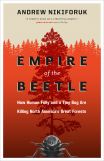 Lisa Danielson, Environment and Natural Resource Policy Intern
Lisa Danielson, Environment and Natural Resource Policy Intern
December 9, 2011
“It’s not something you’ve ever seen before. It’s like a tsunami that takes twenty-five years instead of two seconds” Keith Dufresne, manager of the Cariboo-Chilcotin Beetle Action Coalition
In Andrew Nikiforuk’s latest book, “The Empire of the Beetle”, the bark beetle outbreak that has killed over 30 billion pine and spruce trees is described in great detail. The story is told like a parable, staring the little bug that significantly disrupted a huge industry.
Chapter three, “The Lodgepole Tsunami”, describes how the outbreak took over British Columbia. Beginning with the biology of the beetle, he explains how beetles and pine trees have coexisted in harmony for decades. So how did a harmonious balance turn into an outbreak that devastated B.C’s forests?
First, the British Columbia forest industry was based on a model of “cost minimization and volume maximization”(52). The model led to a policy of fire suppression, following the logic that lost trees to fires meant lost dollars. This policy was a “multi-million dollar annual effort created a more uniform, dense, and expansive patch of adding lodge poles”(60). This is how “cost minimization and volume maximization” turned what was originally an age diverse forest into a monoculture of aging pine trees, or in other words, how a short term economic decision created long term ecological consequences.
However, fire suppression was not the only culprit in creating a perfect setting for a beetle population surge. “Dedicated firefighting may have set the table, but it looked as if climate change had reconfigured the table’s shape and size, so that it now extended into northern and alpine forests” (61). A subtle regular warming had removed the restraints cold weather had put on beetle population growth.
This is how human action set the scene for the unprecedented epidemic.
The beetle outbreak was met with a series of policy decisions that did nothing to slow it down. In 1996, the federal government abandoned the Canada’s Forest Insects Disease Survey (FIDS) to save money. While the duty of monitoring forest health was officially passed on to the provinces, it took a few years for British Columbia to pick up the slack. This resulted in no surveys in 1997 or 1998, which were both critical to the mountain pine beetle increase. Better monitoring may not have changed the course of the outbreak, it could definitely have shaped a superior, more informed response.
Allan Carroll, now with UBC’s Department of Forest Sciences, advised the park service that the best plan was to “predict the outbreak’s size and determine what was driving it”(55). Instead, a series of war like tactics where employed in efforts to kill the beetles. First, nearly a million dollars was spent on a “fell and burn” program, which involved cutting down and burning individual infested trees. After this didn’t work, a “snip’n'skid” program was put into place, followed by a “hack and squirt”. Hack and squirt was cutting into the tree and then injecting arsenic into it. In 2006, it came out that the arsenic was not just killing beetles but in addition killing fifteen species of woodpecker, the beetle’s best natural predator.
In response to the ever-growing beetle outbreak, in 2001 the annual allowable cut was increased to “salvage dead wood”. At the same time stumpage fees were lowered and mills expanded, upping the production and transportation of beetle kill wood. Of course, this resulted in some unintended environmental consequences, such as the transportation of beetle infested trees creating outbreaks along the highways (63).
In 2001 the province also commissioned a review on the costs and benefits of clear-cutting the beetle kill (which of course, they were already doing). The results of the review showed that letting the dying trees stay allowed natural processes of forest regeneration to continue, while removing the trees negatively impacted wildlife diversity and habitat. According the Nikiforuk, the results of this review where ignored.
In 2009, The B.C. Forest Practices Board released a report about the clear cuts that concluded, “The ecological consequences of salvage harvesting on a spatial scale” had “no precedent globally”(100).
While this book offered interesting insight into what policy choices helped contribute to the mismanagement of the crisis, the real value of it comes from the personal accounts Nikiforuk collects. The book is mainly focused on the emotive aspect of the beetle outbreak, and how the forest destruction affects the people and the animals that depend on it. Through personal interviews and stories, Nikiforuk paints a truly tragic story of environmental ruin.
Andrew Nikiforuk. The Empire of the Beetle: How Human Folly and a Tiny Bug Are Killing North America’s Great Forests. Vancouver: Greystone Books and the David Suzuki Foundation. 2011.
For more information about the environmental effects of the mountain pine beetle epidemic in British Colubmia, journalist Larry Pynn had a 5-part series in the Vancouver Sun this past week.
